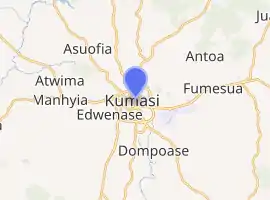Kejetia, Kumasi, Ghana
The Kumasi Central Market (also known as Kejetia Market) is an open-air market in the city of Kumasi, the capital of Ashanti. Kumasi Central Market is in the rain forest bioregion of Ashanti on the Ashantiland Peninsula. Kumasi is approximately 300 miles (480 km) north of the Equator and 100 miles (160 km) north of the Gulf of Guinea. Kumasi is popularly known as "The Garden City" or "heart beat" of Ashanti and the Ashantiland Peninsula because of its many beautiful species of flowers and plants.

| |
| Location | Kumasi, Ghana |
|---|---|
| Coordinates | 6.698635°N 1.619140°W |
| Address | Kumasi Metropolitan Assembly |
| Opening date | Kejetia Refurbishment Completion December 2016 (or January 2017) |
| Closing date | February 2016 |
| Developer | Contracta Engenharia |
| Management | Kumasi Metropolitan Assembly Ashanti Absolute Monarchy |
| Owner | Kumasi Metropolitan Assembly Asantehene |
| Architect | Contracta Engenharia |
| No. of stores and services | 10,000+[1] |
The Kejetia market is the largest single market in West Africa.[2] It has over 10,000 stores and stalls.[1]
About the market
Right in the heart of Kumasi is one of West Africa's largest open air markets. It is bordered to the north by the Kumasi Cultural Centre and to the north west by the Komfo Anokye Teaching Hospital. The southern part of the Kejetia market forms a border with Adum, the commercial centre of the cty. Virtually everything that one wants to purchase from a market can be found at Kumasi Central Market. Kejetia market ranges from gold jewelry and diamond jewellery handcrafted by the Ashantis, food, Ashanti kente clothing fabrics and footwear by Printex, spices, grains, and toiletries. If a person is traveling with someone, it is necessary to stay close since it is very easy to lose one another and easy to lose one's way. Kejetia market is a great place to buy fabric such as the Ashanti people's kente clothing, and see a huge Kejetia market, full of everyday hustle and bustle.
Redevelopment of the market
Due to the spontaneous development of uncontrolled sprouting of vendors, uncountable fire outbreaks the government set out a well thought through redevelopment plan of the entire Kejetia market enclave. The redevelopment was to undertaken in three major phases.[3]
PHASE 1
The first phase of the redevelopment started in 2015 and was valued at a cost of US$259,425,000 by the John Dramani Mahama government.[4] The first phase of the project, included an ultra-modern market with 8,420 stores, a clinic, a police station, a social and recreational centre, ICT centre and a post office, a fire post, banks and a day-care centre. It was completed in late 2018.[5] [6]
PHASE 2
Sod cutting for the phase two redevelopment of the Kumasi Central Market was done by Nana Addo Dankwah and Otumfuo Osei Tutu II, the Asantehene on 2 May 2019 for work to commence. The phase two is estimated to cost 248 million financed by Deutsche Bank of Germany with credit guarantee from UK Export finance to be completed within a time frame of 48 months[5]
When completed the market will have 6500 leased stores commercially, 5,400 stores closed, 800 kiosks, 50 restaurants, 40 livestock stores, 210 fish monger and butcher spaces and community facilities of 1,800 square meters.[7] It is estimated to cover a total area of 172,197 square meters.[5]
Market management
The huge human and vehicular traffic in and around the Kejetia market makes its management and law enforcement very difficult. Various methods of ensuring peace and order in the area are employed include the formation of a city guard group. The members of the group act as the Kejetia market's law enforcement authority. They handle basic traffic direction duties, anti-hawking activities, etc. However, they refer all cases that are beyond the jurisdiction to the Kejetia Police Personnel who have a station in the market. In 2010, the Kumasi Metropolitan Assembly through the market managers Freko FD Ltd installed CCTV cameras around the market,[8] with the aim of strengthening security at the station. The move was expected to clamp down on hoodlums, who ply their trade in areas including the Kumasi Central market, PZ-Adum, Zoological gardens and its environs.
Fires
Fire outbreaks have historically been the major destroyer of the Kejetia market. The Kejetia market has had several outbreaks that have resulted in the destruction of stores, stalls and their wares. The destruction in most cases runs into several millions of cedis.
One outbreak occurred on 19 September 2001,[9] when a blazing hail of fire gutted over 150 stores at the old Kejetia market. It took the intervention of the Kumasi City Fire Service to fight the fire from spreading to other stores. The cost of items destroyed was not readily assessed. The cause was attributed to illegal electrical connections performed by workers of a private developer.
See also
References
- "Kajetia Kajetia". KMA. Archived from the original on 2011-03-10.
- "€248m approved for Kumasi Central Market". www.pulse.com.gh. 2018-08-09. Retrieved 2019-05-02.
- "$298 million Kejetia-Central Market to take off". Graphic Online. Retrieved 2020-09-26.
- myadmin (2016-01-22). "First phase of Kejetia market project progressing steadily". Ghana Business News. Retrieved 2020-09-26.
- "Kumasi Central Market redevelopment construction works begins". Graphic Online. Retrieved 2019-05-02.
- "Asantehene orders reopening of newly built Kejetia Market". MyJoyOnline.com. 2019-05-02. Retrieved 2020-09-26.
- "Akufo-Addo cut sod for €248m phase II of Kumasi Central Market project". www.myjoyonline.com. Retrieved 2019-05-02.
- "CCTV Cameras Fixed at Kejetia". todaygh.com. Archived from the original on 2011-10-09.
- "Kejetia outbreak".
.JPG.webp)